Online Surface Roughness Prediction for Assembly Interfaces of Vertical Tail Integrating Tool Wear under Variable Cutting Parameters
Abstract
:1. Introduction
2. Related Work
2.1. Surface Roughness Prediction with Indirect Sensors
2.1.1. Polynomial Regression Model
2.1.2. Artificial Intelligence Model
2.2. Surface Roughness Prediction with Direct Sensors
2.3. Summary and Analysis
3. Proposed Surface Roughness Prediction Method Considering Tool Wear
3.1. Framework and Working Mechanism of Surface Roughness Prediction for the Assembly Interface
3.2. Fundamental Surface Roughness Prediction Model Based on SAE–LSTM
3.3. Surface Roughness Prediction Model Training Using Transfer Learning
3.3.1. Transfer Learning Strategy Based on a Multi-Stage Model Training Process
3.3.2. Optimization Objective of Multi-Stage Transfer Learning
3.4. Integration of Tool Wear Prediction into Surface Roughness Prediction
3.4.1. Surface Roughness Prediction Integrating Tool Wear
3.4.2. Data Preparation for Surface Roughness Prediction
4. Experiment and Analysis
4.1. Experimental Setup
4.2. Experimental Data Preparation
4.3. Results and Discussion
4.3.1. Model Parameter Setting
4.3.2. Optimal Parameter Selection for the Surface Roughness Prediction Model
- (1)
- Prediction effect using different numbers of fine-tuning samples
- (2)
- Effect of using different lengths of historical data (k) on prediction
4.3.3. Results of Surface Roughness Prediction with Variable Cutting Parameters
5. Conclusions and Future Work
- (1)
- The surface roughness of an assembly interface is predicted by integrating the time-varying characteristics of sensor data and tool wear. This enables the prediction of surface roughness to more accurately reflect the influence of the time-varying machining process on surface roughness;
- (2)
- The multi-time-step input SAE is designed to extract the time-series features of raw input data. It is combined with the LSTM to predict the surface roughness degradation in assembly interface machining;
- (3)
- The proposed SAE–LSTM prediction model adopts transfer learning, which can solve the problem encountered in the online prediction of surface roughness for assembly interfaces under variable cutting parameters;
- (4)
- Ablation studies are implemented by conducting a machining experiment on the assembly interfaces of a titanium alloy vertical tail. The proposed method can predict the surface roughness of assembly interfaces under variable cutting parameters and achieve high prediction accuracy. It provides supporting data and theory for the online monitoring of surface roughness and adjustment of cutting parameters in assembly interface machining. This method can also serve as a reference for the online monitoring of assembly interface machining of spacecraft, wind power equipment, etc.
Author Contributions
Funding
Institutional Review Board Statement
Informed Consent Statement
Data Availability Statement
Acknowledgments
Conflicts of Interest
References
- Kong, D.D.; Zhu, J.J.; Duan, C.Q.; Lu, L.; Chen, D. Surface roughness prediction using kernel locality preserving projection and Bayesian linear regression. Mech. Syst. Signal Proc. 2021, 152, 107474. [Google Scholar] [CrossRef]
- Escalona, P.M.; Maropoulos, P.G. A geometrical model for surface roughness prediction when face milling Al 7075-T7351 with square insert tools. J. Manuf. Syst. 2015, 36, 216–223. [Google Scholar] [CrossRef] [Green Version]
- Rao, P.; Bukkapatnam, S.; Beyca, O.; Kong, Z.Y.; Ranga, K. Real-Time Identification of Incipient Surface Morphology Variations in Ultraprecision Machining Process. J. Manuf. Sci. Eng.-Trans. ASME 2014, 136, 186–204. [Google Scholar] [CrossRef]
- Lei, P.; Zheng, L.Y.; Wang, L.H.; Wang, Y.H.; Li, C.; Li, X.C. MTConnect compliant monitoring for finishing assembly interfaces of large-scale components: A vertical tail section application. J. Manuf. Syst. 2017, 45, 121–134. [Google Scholar] [CrossRef]
- Aris, N.F.M.; Cheng, K. Characterization of the surface functionality on precision machined engineering surfaces. Int. J. Adv. Manuf. Technol. 2008, 38, 402–409. [Google Scholar] [CrossRef]
- Grzesik, W. Advanced Machining Processes of Metallic Materials; Elsevier: Amsterdam, The Netherlands, 2008; pp. 405–420. [Google Scholar]
- Liang, X.L.; Liu, Z.Q.; Wang, B. State-of-the-art of surface integrity induced by tool wear effects in machining process of titanium and nickel alloys: A review. Measurement 2018, 132, 150–181. [Google Scholar] [CrossRef]
- Liang, Y.C.; Liu, J.S.; Sun, Y.Z.; Lu, L.H. Surface Roughness Effects on Vortex Torque of Air Supported Gyroscope. Chin. J. Aeronaut. 2011, 24, 90–95. [Google Scholar] [CrossRef] [Green Version]
- Li, X.; Guan, C.M.; Zhao, P. Influences of milling and grinding on machined surface roughness and fatigue behavior of GH4169 superalloy workpieces. Chin. J. Aeronaut. 2018, 31, 1399–1405. [Google Scholar] [CrossRef]
- Liu, J.; Li, Z.L.; Hanachi, L. A physics-based framework for online surface roughness assessment for high-pressure turbines. Chin. J. Aeronaut. 2021, 34, 135–156. [Google Scholar] [CrossRef]
- Wang, M.Y.; Yang, C.W.; Li, Z.L.; Zhao, S.F.; Zhang, Y.; Lu, X. Effects of surface roughness on the aerodynamic performance of a high subsonic compressor airfoil at low Reynolds number. Chin. J. Aeronaut. 2021, 34, 71–81. [Google Scholar] [CrossRef]
- Duan, Z.J.; Li, C.H.; Zhang, Y.B.; Dong, L.; Bai, X.; Yang, M.; Jia, D.; Li, R.; Cao, H.; Xu, X. Milling surface roughness for 7050 aluminum alloy cavity influenced by nozzle position of nanofluid minimum quantity lubrication. Chin. J. Aeronaut. 2021, 34, 33–53. [Google Scholar] [CrossRef]
- Rifai, A.P.; Aoyama, H.; Tho, N.H.; Dawal, S.Z.M.; Masruroh, N.A. Evaluation of turned and milled surfaces roughness using convolutional neural network. Measurement 2020, 161, 107860. [Google Scholar] [CrossRef]
- Dhanasekar, B.; Ramamoorthy, B. Restoration of blurred images for surface roughness evaluation using machine vision. Tribol. Int. 2010, 43, 268–276. [Google Scholar] [CrossRef]
- Laopornpichayanuwat, W.; Visessamit, J.; Tianprateep, M. 3-D Surface roughness profile of 316-stainless steel using vertical scanning interferometry with a superluminescent diode. Measurement 2012, 45, 2400–2406. [Google Scholar] [CrossRef]
- Nwaogu, U.C.; Tiedje, N.S.; Hansen, H.N. A non-contact 3D method to characterize the surface roughness of castings. J. Mater. Process. Technol. 2013, 213, 59–68. [Google Scholar] [CrossRef]
- Samtaş, G. Measurement and evaluation of surface roughness based on optic system using image processing and artificial neural network. Int. J. Adv. Manuf. Technol. 2014, 73, 353–364. [Google Scholar] [CrossRef]
- Bhuiyan, M.S.H.; Choudhury, I.A.; Dahari, M. Monitoring the tool wear, surface roughness and chip formation occurrences using multiple sensors in turning. J. Manuf. Syst. 2014, 33, 476–487. [Google Scholar] [CrossRef]
- Liu, D.S.; Luo, M.; Pelayo, G.U.; Trejo, D.O.; Zhang, D.H. Position-oriented process monitoring in milling of thin-walled parts. J. Manuf. Syst. 2020, 60, 360–372. [Google Scholar] [CrossRef]
- Ha, A.; Hy, B. Experimental and statistical investigation of the effect of cutting parameters on surface roughness, vibration and energy consumption in machining of titanium 6Al-4V ELI (grade 5) alloy. Measurement 2020, 167, 108465. [Google Scholar]
- Maher, I.; Eltaib, M.; Sarhan, A. Cutting force-based adaptive neuro-fuzzy approach for accurate surface roughness prediction in end milling operation for intelligent machining. Int. J. Adv. Manuf. Technol. 2015, 76, 1459–1467. [Google Scholar] [CrossRef]
- Khorasani, A.M.; Yazdi, M.R.S.; Safizadeh, M.S. Analysis of machining parameters effects on surface roughness: A review. Int. J. Comput. Mater. Sci. Surf. Eng. 2012, 5, 68–84. [Google Scholar] [CrossRef]
- Yip, W.S.; To, S.; Zhou, H.T. Social network analysis for optimal machining conditions in ultra-precision manufacturing. J. Manuf. Syst. 2020, 56, 93–103. [Google Scholar] [CrossRef]
- Ahmet, A.; Sakir, Y.; Haci, S.; Mesut, U. The Effects of Cutting Speed and Depth of Cut on Machinability Characteristics of Austempered Ductile Iron. J. Manuf. Sci. Eng.-Trans. ASME 2014, 134, 021013. [Google Scholar]
- Wang, Y.H.; Zheng, L.Y.; Wang, Y.W. Event-driven tool condition monitoring methodology considering tool life prediction based on industrial internet. J. Manuf. Syst. 2021, 58, 205–222. [Google Scholar] [CrossRef]
- Wang, B.; Zhang, Q.; Wang, M.H.; Zheng, Y.H.; Kong, X.J. A predictive model of milling surface roughness. Int. J. Adv. Manuf. Technol. 2020, 108, 2755–2762. [Google Scholar] [CrossRef]
- Tangjitsitcharoen, S.; Thesniyom, P.; Ratanakuakangwan, S. Prediction of surface roughness in ball-end milling process by utilizing dynamic cutting force ratio. J. Intell. Manuf. 2014, 28, 13–21. [Google Scholar] [CrossRef]
- Panda, A.; Sahoo, A.K.; Panigrahi, I.; Rout, A.K. Prediction models for on-line cutting tool and machined surface condition monitoring during hard turning considering vibration signal. Mech. Ind. 2020, 21, 520. [Google Scholar] [CrossRef]
- Liu, N.; Wang, S.B.; Zhang, Y.F.; Lu, W.F. A novel approach to predicting surface roughness based on specific cutting energy consumption when slot milling Al-7075. Int. J. Mech. Sci. 2016, 118, 13–20. [Google Scholar] [CrossRef]
- Deshpande, Y.; Andhare, A.; Sahu, N.K. Estimation of surface roughness using cutting parameters, force, sound, and vibration in turning of Inconel 718. J. Braz. Soc. Mech. Sci. Eng. 2017, 39, 5087–5096. [Google Scholar] [CrossRef]
- Guo, W.C.; Wu, C.J.; Ding, Z.S. Prediction of surface roughness based on a hybrid feature selection method and long short-term memory network in grinding. Int. J. Adv. Manuf. Technol. 2021, 112, 2853–2871. [Google Scholar] [CrossRef]
- Wu, T.Y.; Lei, K.W. Prediction of surface roughness in milling process using vibration signal analysis and artificial neural network. Int. J. Adv. Manuf. Technol. 2019, 102, 305–314. [Google Scholar] [CrossRef]
- Huang, P.T.B.; Zhang, H.J.; Lin, Y.C. Development of a Grey online modeling surface roughness monitoring system in end milling operations. J. Intell. Manuf. 2019, 30, 1923–1936. [Google Scholar] [CrossRef]
- Gerardo, B.; Fernando, C.; Haber, R.E.; Ramón, Q.; Alberto, V. Coping with Complexity When Predicting Surface Roughness in Milling Processes: Hybrid Incremental Model with Optimal Parametrization. Complexity 2017, 2017, 7317254. [Google Scholar]
- Nan, X.; Zhou, J.F.; Zheng, B.R. An energy-based modeling and prediction approach for surface roughness in turning. Int. J. Adv. Manuf. Technol. 2018, 96, 2293–2306. [Google Scholar]
- Abu-Mahfouz, I.; Rahman, A.E.; Banerjee, A. Surface Roughness Prediction in Turning Using Three Artificial Intelligence Techniques; A Comparative Study. Procedia Comput. Sci. 2018, 140, 258–267. [Google Scholar] [CrossRef]
- Plaza, E.G.; Lopez, P.J.N. Surface roughness monitoring by singular spectrum analysis of vibration signals. Mech. Syst. Signal Proc. 2017, 84, 516–530. [Google Scholar] [CrossRef]
- Chen, Y.N.; Sun, R.L.; Gao, Y.; Leopold, J. A nested-ANN prediction model for surface roughness considering the effects of cutting forces and tool vibrations. Measurement 2017, 98, 25–34. [Google Scholar] [CrossRef]
- Kumar, S.N.; Andhare, A.B.; Sandip, A.; Raju, A.R. Prediction of surface roughness in turning of Ti-6Al-4V using cutting parameters, forces and tool vibration. IOP Conf. Ser. Mater. Sci. Eng. 2018, 346, 012037. [Google Scholar] [CrossRef] [Green Version]
- Liu, J.; Lu, E.H.; Yi, H.A.; Wang, M.; Ao, P. A new surface roughness measurement method based on a color distribution statistical matrix. Measurement 2017, 103, 165–178. [Google Scholar] [CrossRef]
- Prabhakar, D.V.N.; Kumar, M.S.; Krishna, A.G. A Novel Hybrid Transform approach with integration of Fast Fourier, Discrete Wavelet and Discrete Shearlet Transforms for prediction of surface roughness on machined surfaces. Measurement 2020, 164, 108011. [Google Scholar] [CrossRef]
- Tootooni, M.S.; Liu, C.; Roberson, D.; Donovan, R.; Rao, P.K.; Kong, Z. Online non-contact surface finish measurement in machining using graph theory-based image analysis. J. Manuf. Syst. 2016, 41, 266–276. [Google Scholar] [CrossRef]
- Chiou, R.Y.; Kwon, Y.J.; Tseng, T.L.B.; Mauk, M. Experimental Study of High Speed CNC Machining Quality by Noncontact Surface Roughness Monitoring. Int. J. Mech. Eng. Rob. Res. 2015, 4, 282–286. [Google Scholar] [CrossRef]
- Jeyapoovan, T.; Murugan, M. Surface roughness classification using image processing. Measurement 2013, 46, 2065–2072. [Google Scholar] [CrossRef]
- Shahabi, H.H.; Ratnam, M.M. Noncontact roughness measurement of turned parts using machine vision. Int. J. Adv. Manuf. Technol. 2010, 46, 275–284. [Google Scholar] [CrossRef]
- Cheng, K. Machining Dynamics: Theory, Applications and Practices; Springer: London, UK, 2008; pp. 205–207. [Google Scholar]
- Smithey, D.W.; Kapoor, S.G.; DeVor, R.E. A new mechanistic model for predicting worn tool cutting forces. Mach. Sci. Technol. 2001, 5, 23–42. [Google Scholar] [CrossRef]
- Attanasio, A.; Ceretti, E.; Giardini, C.; Filice, L.; Umbrello, D. Criterion to evaluate diffusive wear in 3D simulations when turning AISI 1045 steel. Int. J. Mater. Form. 2008, 1, 495–498. [Google Scholar] [CrossRef]
- Moradi, H.; Vossoughi, G.; Movahhedy, M.R. Bifurcation analysis of nonlinear milling process with tool wear and process damping: Sub-harmonic resonance under regenerative chatter. Int. J. Mech. Sci. 2014, 85, 1–19. [Google Scholar] [CrossRef]
- Liang, X.; Liu, Z. Tool wear behaviors and corresponding machined surface topography during high-speed machining of Ti-6Al-4V with fine grain tools. Tribol. Int. 2018, 121, 321–332. [Google Scholar] [CrossRef]
- Chen, Y.; Lin, Z.; Xing, Z.; Gang, W.; Gu, Y. Deep Learning-Based Classification of Hyperspectral Data. IEEE J. Sel. Top. Appl. Earth Obs. Remote Sens. 2017, 7, 2094–2107. [Google Scholar] [CrossRef]
- Zheng, J.M.; Cai, F.; Chen, H.H.; Rijke, M.D. Pre-train, Interact, Fine-tune: A novel interaction representation for text classification. Inf. Process. Manag. 2020, 57, 102215. [Google Scholar] [CrossRef] [Green Version]
- Gretton, A.; Borgwardt, K.M.; Rasch, M.; Scholkopf, B.; Smola, A. A Kernel Two-Sample Test. J. Mach. Learn. Res. 2012, 13, 723–773. [Google Scholar]
- Zhao, X.; Zheng, L.Y.; Yu, L. In-process adaptive milling for large-scale assembly interfaces of a vertical tail driven by real-time vibration data. Chin. J. Aeronaut. 2021. in Press. [Google Scholar] [CrossRef]
- Fan, W.; Zheng, L.Y.; Zhao, X.; Yang, Y.Q. Vibration attenuation for finishing assembly interfaces of vertical tail section of large aircraft based on novel eddy current damper. Chin. J. Aeronaut. 2019, 40, 340–356. [Google Scholar]
- Pimenov, D.Y.; Bustillo, A.; Mikolajczyk, T. Artificial intelligence for automatic prediction of required surface roughness by monitoring wear on face mill teeth. J. Intell. Manuf. 2017, 29, 1045–1061. [Google Scholar] [CrossRef] [Green Version]
- Lin, W.J.; Lo, S.H.; Young, H.T.; Hung, C.L. Evaluation of Deep Learning Neural Networks for Surface Roughness Prediction Using Vibration Signal Analysis. Appl. Sci. 2019, 9, 1462. [Google Scholar] [CrossRef] [Green Version]
- Xu, L.H.; Huang, C.Z.; Niu, J.H.; Wang, J.; Liu, H.L.; Wang, X.D. Prediction of cutting power and surface quality, and optimization of cutting parameters using new inference system in high-speed milling process. Adv. Manuf. 2021, 9, 388–402. [Google Scholar] [CrossRef]
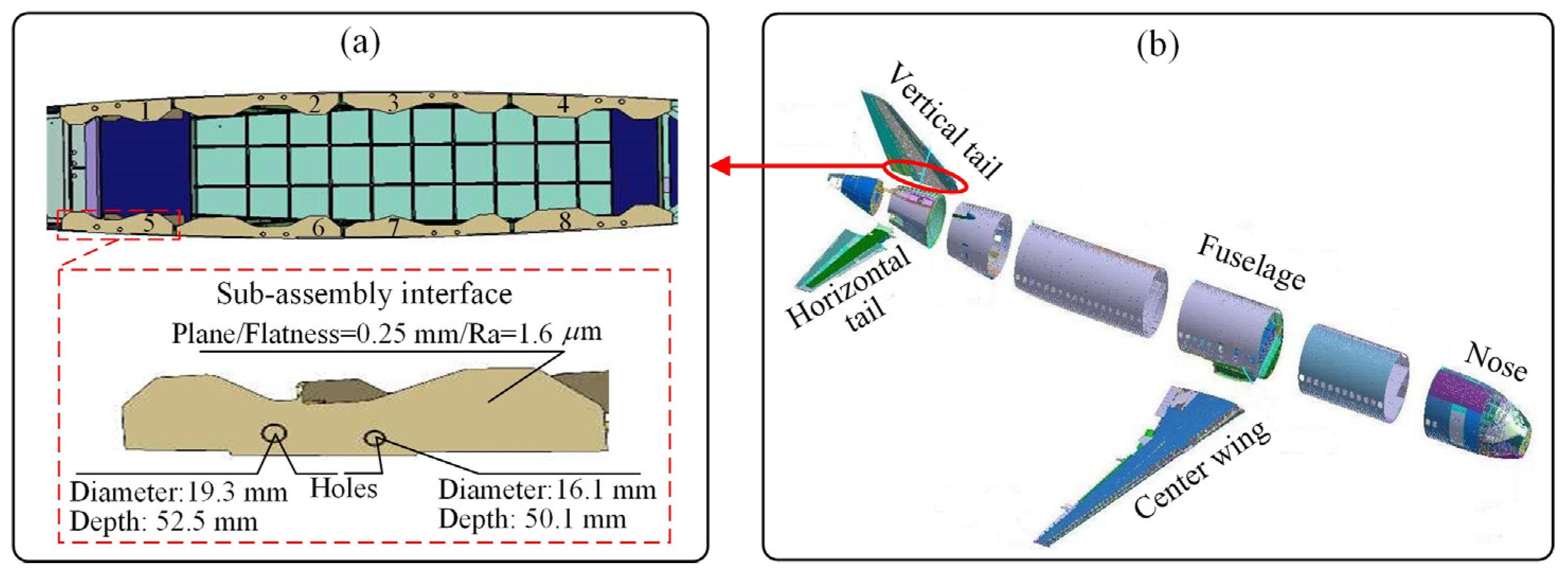

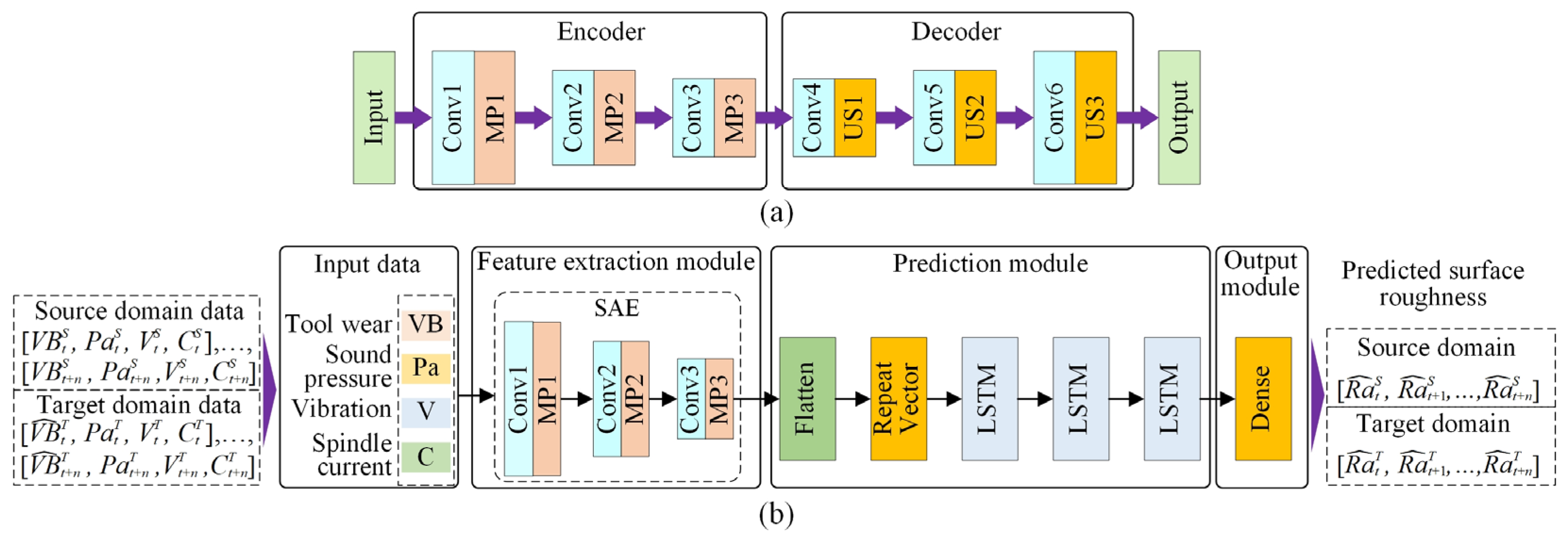

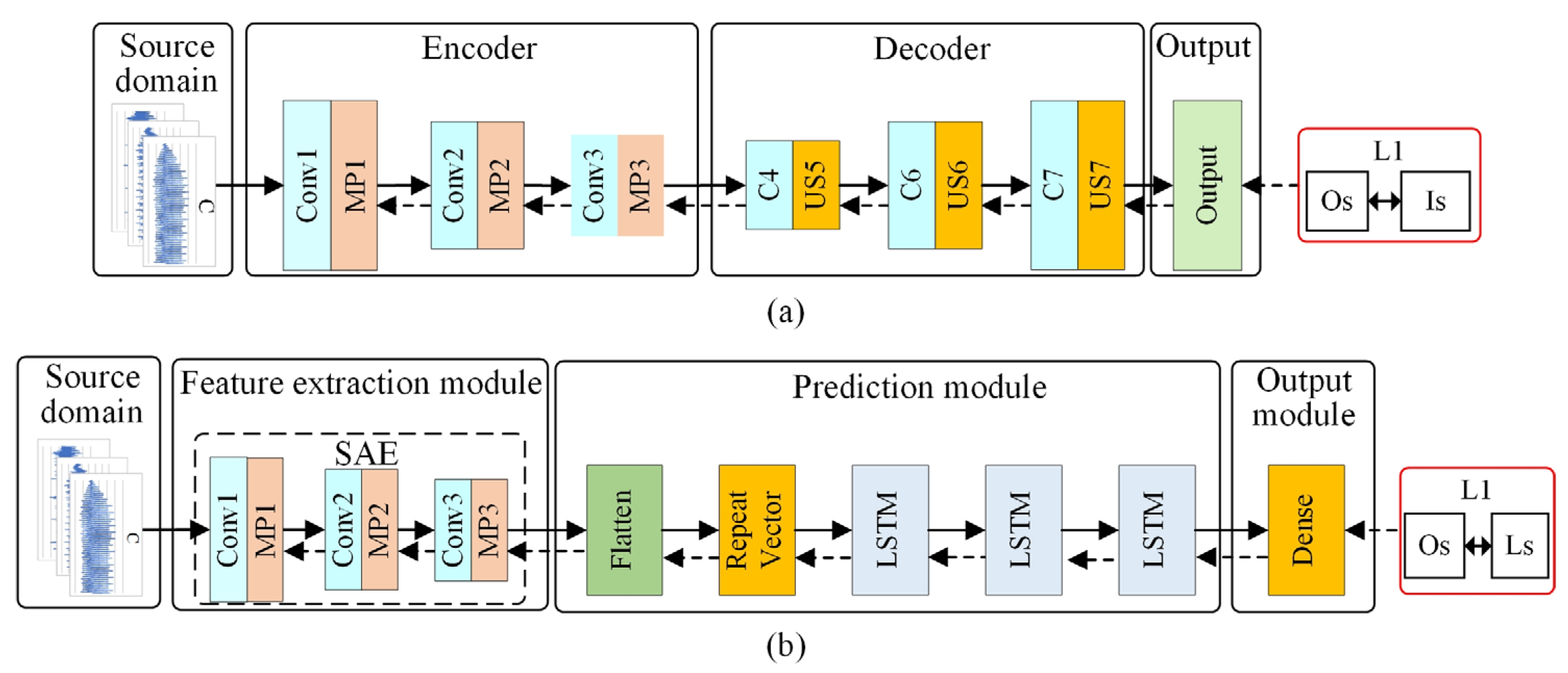
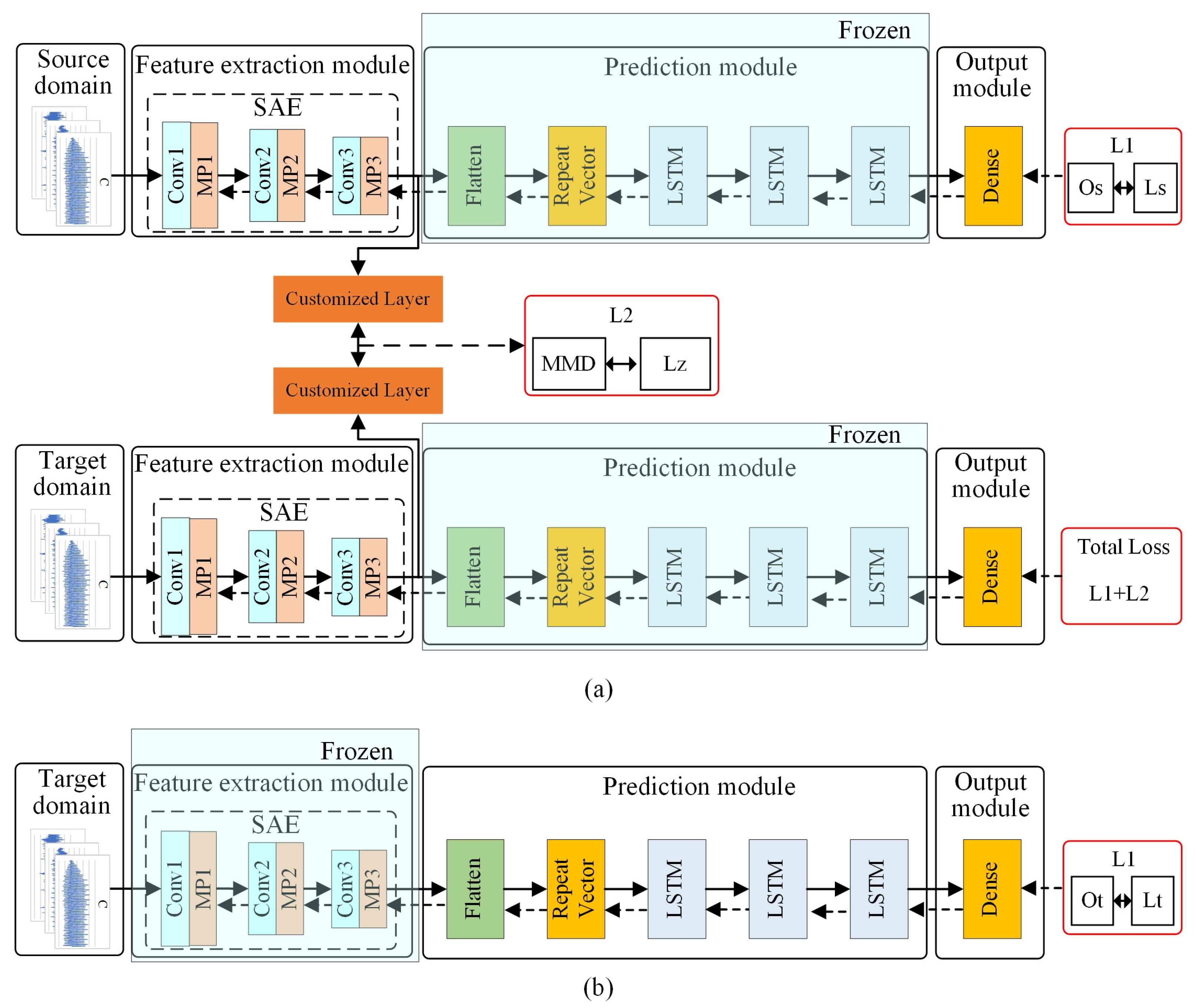
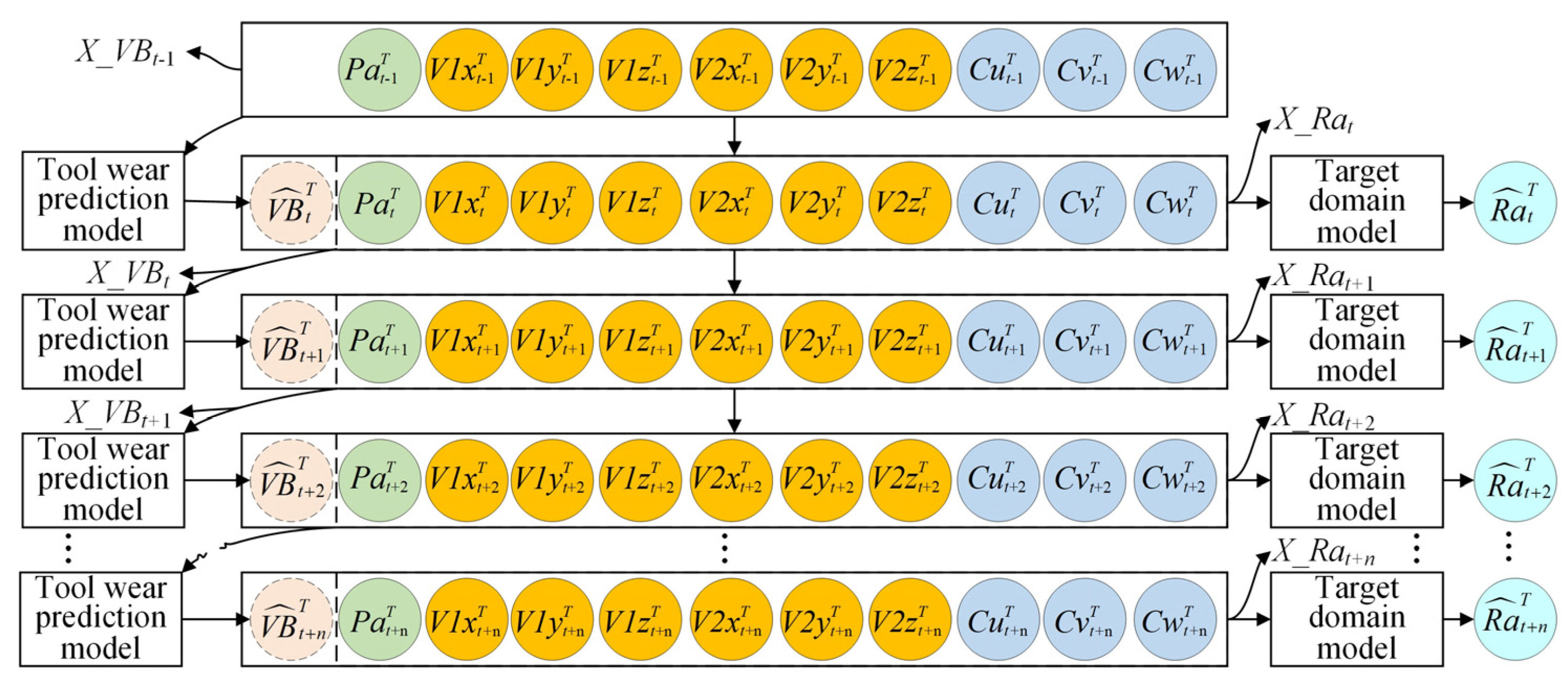

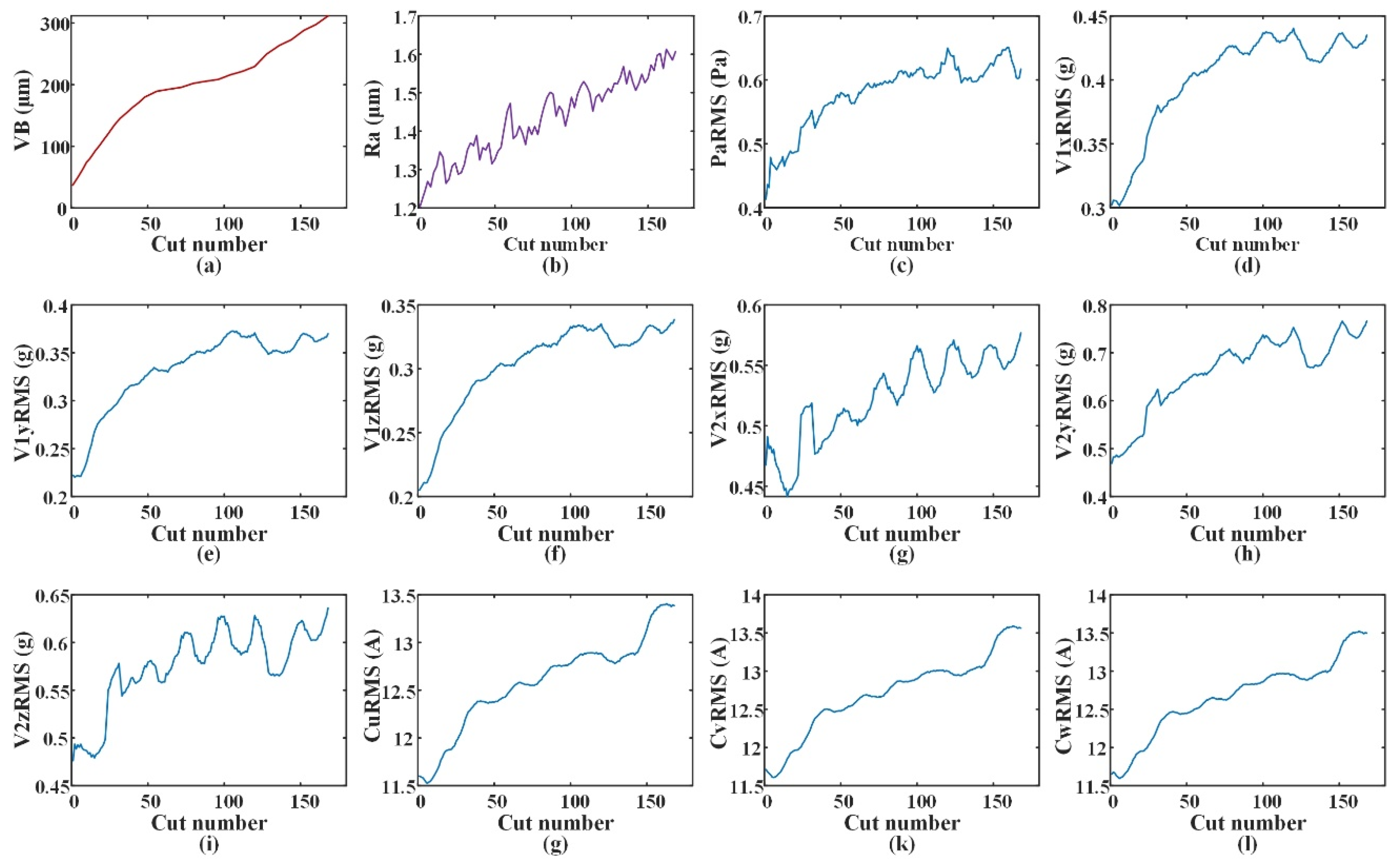
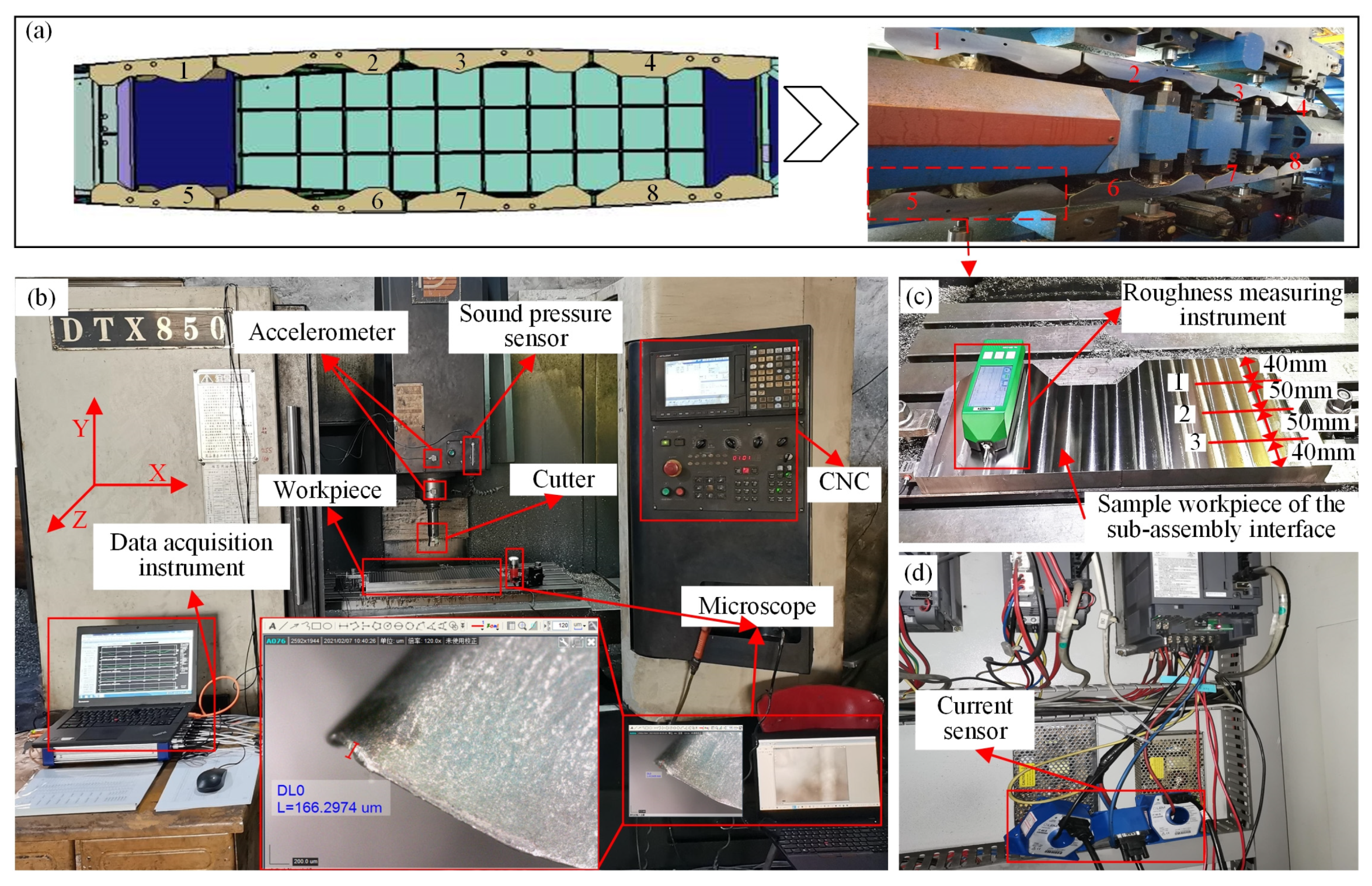
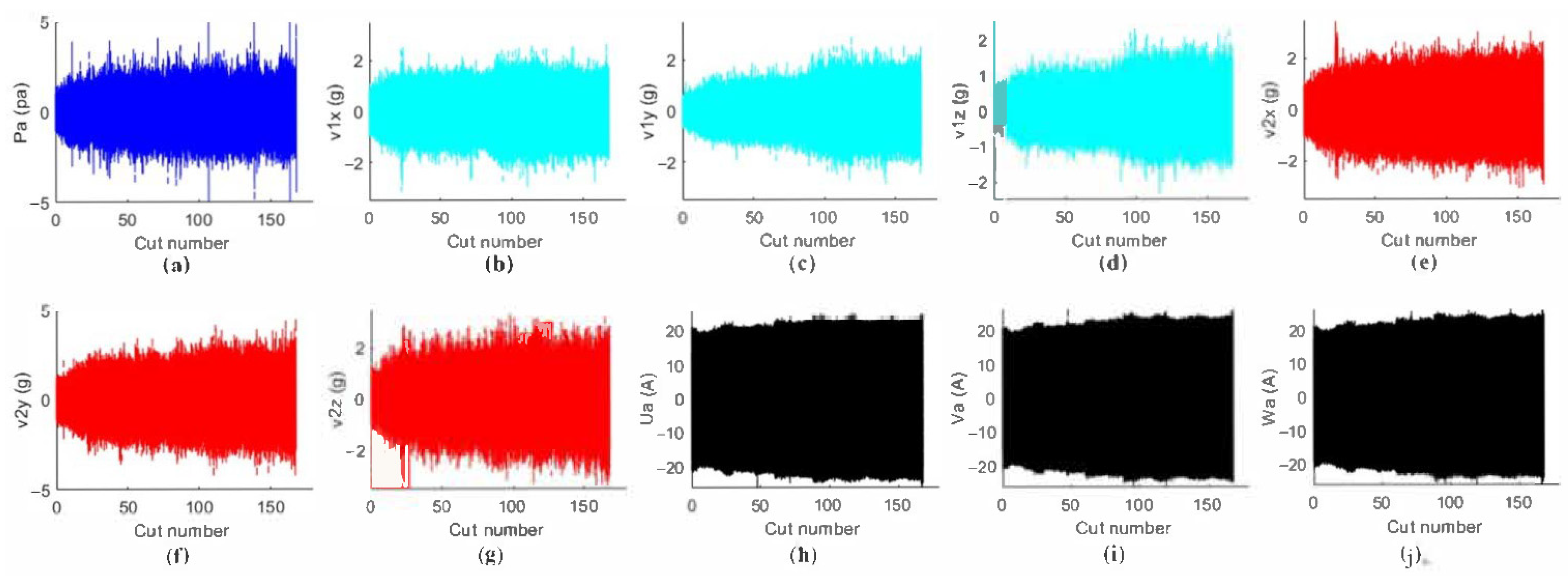

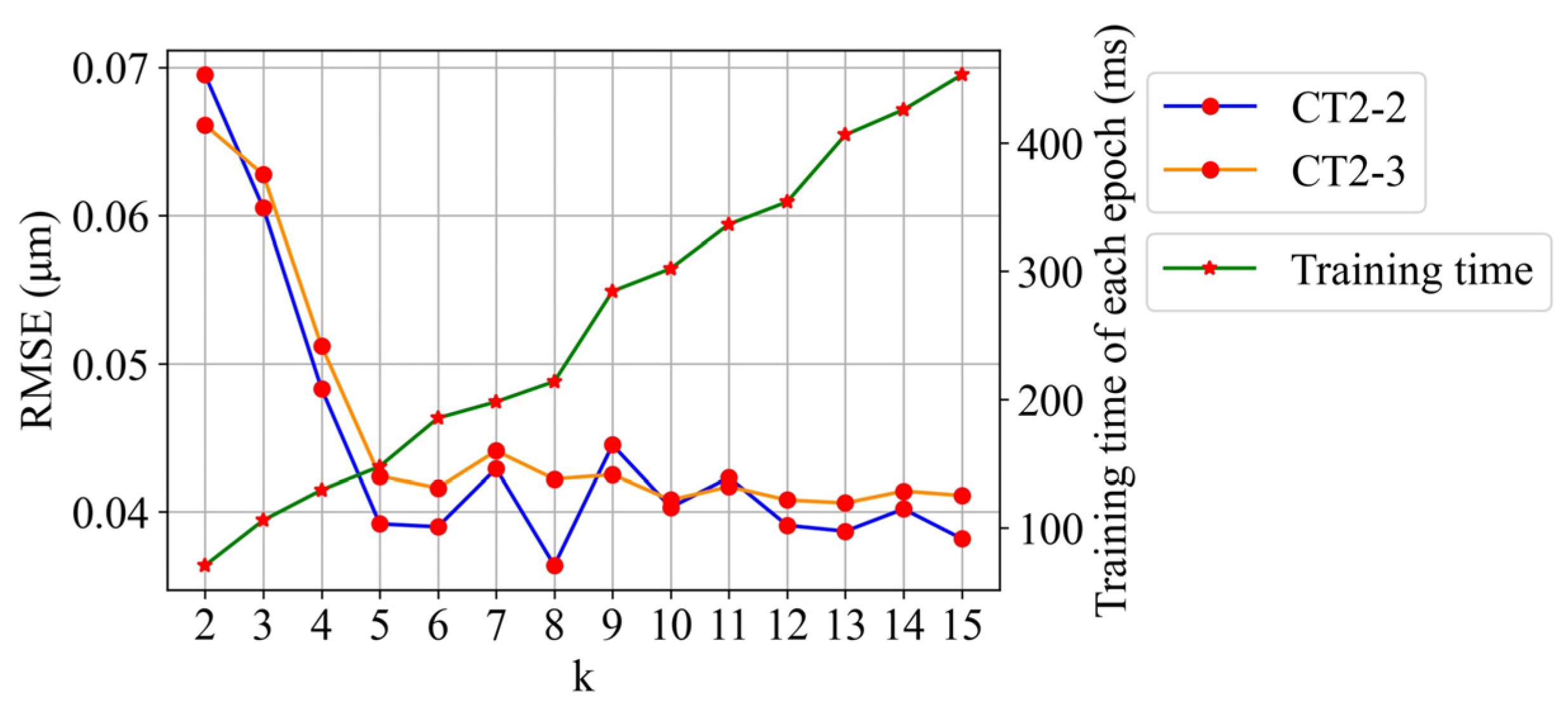
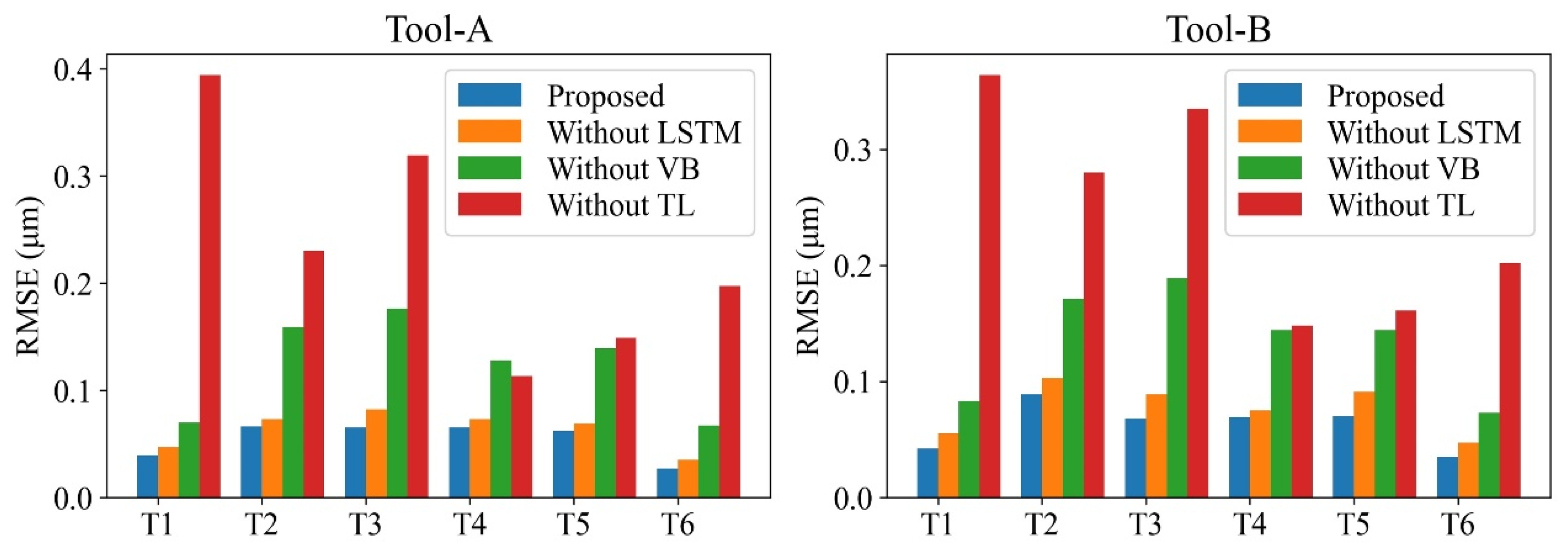
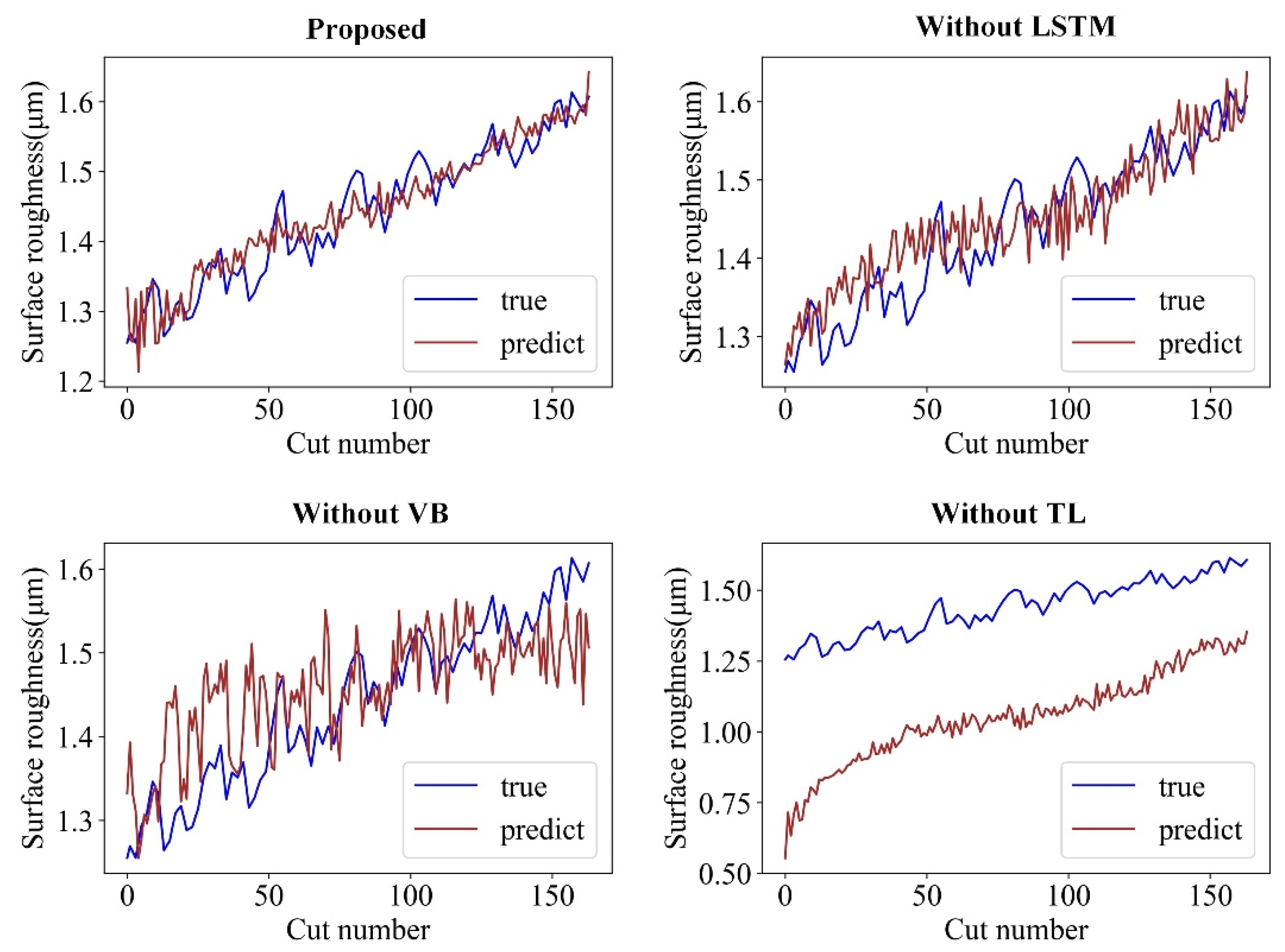
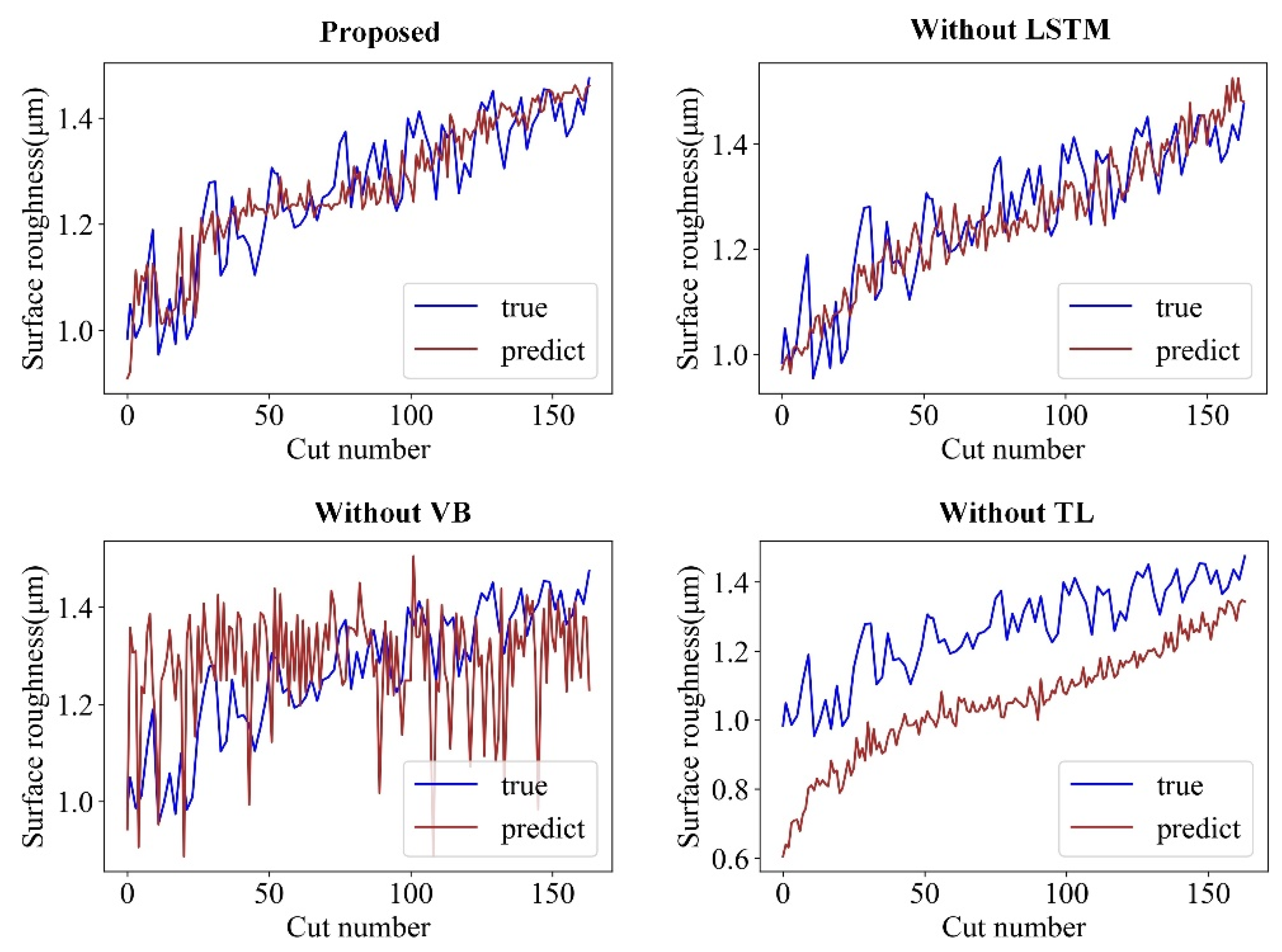
| NO. | Term | Explanation |
|---|---|---|
| 1 | Source domain | Machining conditions with complete data (e.g., sensor data, tool wear data, surface roughness data, and cutting parameters) |
| 2 | Target domain | Machining conditions that differ from the cutting parameters of the source domain and have incomplete data (e.g., lack of tool wear data and surface roughness data) |
| 3 | Source domain data | Data collected under the source domain (e.g., data of tool wear, sound pressure sensor, accelerometer, and current sensor) |
| 4 | Target domain data | Data collected under the target domain (e.g., data of tool wear, sound pressure sensor, accelerometer, and current sensor) |
| 5 | Source domain model | Surface roughness prediction model trained with source domain data |
| 6 | Target domain model | Surface roughness prediction model trained with transfer learning |
| 7 | Variable cutting parameters | Different cutting parameters of machining assembly interface in the source and target domains |
| 8 | Ground truth labels | Surface roughness values of assembly interface that are measured offline by a contact device under the source or target domain |
| Cutter Material | Cutter Diameter, D, mm | The Number of Inserts, Nz | Cutting Edge Radius, r, mm | Back Angle, α, ° |
|---|---|---|---|---|
| Carbide | 50 | 4 | 0.8 | 11 |
| Group no. of Cutting Parameters | Feed Rate, f (mm/min) | Axial Depth of Cut, ap (mm) | Spindle Speed, n (r/min) | No. of Tested Cutting Tools |
|---|---|---|---|---|
| P1 | 210 | 0.5 | 450 | CT1-1–CT1-3 |
| P2 | 290 | 0.5 | 500 | CT2-1–CT2-3 |
| P3 | 250 | 0.5 | 380 | CT3-1–CT3-3 |
| Transfer Task No. | Direction of Transfer Task (Source Domain→Target Domain) | Training Data | Test Data | |
|---|---|---|---|---|
| Tool-A | Tool-B | |||
| T1 | P1→P2 | CT1-1–CT1-3, CT2-1 | CT2-2 | CT2-3 |
| T2 | P1→P3 | CT1-1–CT1-3, CT3-1 | CT3-2 | CT3-3 |
| T3 | P2→P1 | CT2-1–CT2-3, CT1-1 | CT1-2 | CT1-3 |
| T4 | P2→P3 | CT2-1–CT2-3, CT3-1 | CT3-2 | CT3-3 |
| T5 | P3→P1 | CT3-1–CT3-3, CT1-1 | CT1-2 | CT1-3 |
| T6 | P3→P2 | CT3-1–CT3-3, CT2-1 | CT2-2 | CT2-3 |
| Task | Training | Testing | |||
|---|---|---|---|---|---|
| Stage 1 (Number of Source Domain Samples) | Stage 2 (Number of Source Domain Samples) | Stage 3 (Number of Source Domain/Number of Unlabeled Target Domain Samples) | Stage 4 (Labeled Target Domain Samples) | Test Stage Samples | |
| T1 | 164 samples of CT1-1 | 164 samples of CT1-2 | 164 samples of CT1-3/164 samples of CT2-1 | 10 samples of CT2-1 | 328 |
| T2 | 164 samples of CT1-1 | 164 samples of CT1-2 | 164 samples of CT1-3/164 samples of CT3-1 | 10 samples of CT3-1 | 328 |
| T3 | 164 samples of CT2-1 | 164 samples of CT2-2 | 164 samples of CT2-3/164 samples of CT1-1 | 10 samples of CT1-1 | 328 |
| T4 | 164 samples of CT2-1 | 164 samples of CT2-2 | 164 samples of CT2-3/164 samples of CT3-1 | 10 samples of CT3-1 | 328 |
| T5 | 164 samples of CT3-1 | 164 samples of CT3-2 | 164 samples of CT3-3/164 samples of CT1-1 | 10 samples of CT1-1 | 328 |
| T6 | 164 samples of CT3-1 | 164 samples of CT3-2 | 164 samples of CT3-3/164 samples of CT2-1 | 10 samples of CT2-1 | 328 |
| Tool Wear Prediction Model | Surface Roughness Prediction Model | ||||||||||
|---|---|---|---|---|---|---|---|---|---|---|---|
| Layer | Symbol | Activation Function | Output Shape | Layer | Symbol | Activation Function | Output Shape | Layer | Symbol | Activation Function | Output Shape |
| 1 | Input | / | (5,20) | 1 | Input | / | (50,000,11) | 10 | LSTM | ReLU | (1,64) |
| 2 | LSTM | ReLU | (5,32) | 2 | Conv1D | ReLU | (50,000,16) | 11 | LSTM | ReLU | (1,32) |
| 3 | LSTM | ReLU | (5,128) | 3 | MaxPooling1D | / | (2500,16) | 12 | LSTM | ReLU | (1,16) |
| 4 | Flatten | / | (640) | 4 | Conv1D | ReLU | (2500,8) | 13 | Dense | / | (1,1) |
| 5 | Repeat Vector | / | (1,640) | 5 | MaxPooling1D | / | (250,8) | ||||
| 6 | LSTM | ReLU | (1,128) | 6 | Conv1D | ReLU | (250,4) | ||||
| 7 | LSTM | ReLU | (1,64) | 7 | MaxPooling1D | / | (25,4) | ||||
| 8 | LSTM | ReLU | (1,32) | 8 | Flatten | / | (100) | ||||
| 9 | Dense | / | (1,1) | 9 | Repeat Vector | / | (1,100) | ||||
| Task | Tool-A (RMSE) | Tool-B (RMSE) | ||||||
|---|---|---|---|---|---|---|---|---|
| Proposed | Without LSTM | Without VB | Without TL | Proposed | Without LSTM | Without VB | Without TL | |
| T1 | 0.039 | 0.047 | 0.070 | 0.394 | 0.042 | 0.055 | 0.083 | 0.364 |
| T2 | 0.066 | 0.073 | 0.159 | 0.230 | 0.089 | 0.103 | 0.171 | 0.280 |
| T3 | 0.065 | 0.082 | 0.176 | 0.319 | 0.068 | 0.089 | 0.189 | 0.335 |
| T4 | 0.065 | 0.073 | 0.128 | 0.113 | 0.069 | 0.075 | 0.144 | 0.148 |
| T5 | 0.062 | 0.069 | 0.139 | 0.149 | 0.070 | 0.091 | 0.144 | 0.161 |
| T6 | 0.027 | 0.035 | 0.067 | 0.197 | 0.035 | 0.047 | 0.073 | 0.202 |
Publisher’s Note: MDPI stays neutral with regard to jurisdictional claims in published maps and institutional affiliations. |
© 2022 by the authors. Licensee MDPI, Basel, Switzerland. This article is an open access article distributed under the terms and conditions of the Creative Commons Attribution (CC BY) license (https://creativecommons.org/licenses/by/4.0/).
Share and Cite
Wang, Y.; Wang, Y.; Zheng, L.; Zhou, J. Online Surface Roughness Prediction for Assembly Interfaces of Vertical Tail Integrating Tool Wear under Variable Cutting Parameters. Sensors 2022, 22, 1991. https://doi.org/10.3390/s22051991
Wang Y, Wang Y, Zheng L, Zhou J. Online Surface Roughness Prediction for Assembly Interfaces of Vertical Tail Integrating Tool Wear under Variable Cutting Parameters. Sensors. 2022; 22(5):1991. https://doi.org/10.3390/s22051991
Chicago/Turabian StyleWang, Yahui, Yiwei Wang, Lianyu Zheng, and Jian Zhou. 2022. "Online Surface Roughness Prediction for Assembly Interfaces of Vertical Tail Integrating Tool Wear under Variable Cutting Parameters" Sensors 22, no. 5: 1991. https://doi.org/10.3390/s22051991
APA StyleWang, Y., Wang, Y., Zheng, L., & Zhou, J. (2022). Online Surface Roughness Prediction for Assembly Interfaces of Vertical Tail Integrating Tool Wear under Variable Cutting Parameters. Sensors, 22(5), 1991. https://doi.org/10.3390/s22051991






